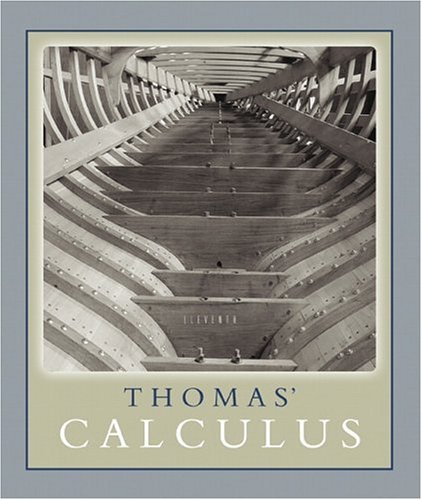
COURSE: MATH 1920-050 Call # 50191
TIME AND PLACE: 9:40-11:10 MTWRF and 8:15-9:30 MW in Gilbreath Hall 314
INSTRUCTOR: Dr. Robert Gardner OFFICE HOURS: By appointment.
OFFICE: Room 308F of Gilbreath Hall
PHONE: 439-6979 (308G Gilbreath), Math Department Office 439-4349
E-MAIL:
gardnerr@etsu.edu
CWEBPAGE:
http://faculty.etsu.edu/gardnerr/gardner.htm (see my webpage for
a copy of this course syllabus, copies of the classnotes in PDF and Postscript format, and updates for the course).
TEXT: Thomas' Calculus, 11th edition, by G. Thomas, R. Finney, M. Weir, and F. Giordano.

SAMPLE TESTS: SAMPLE TESTS: Copies of old tests, along with solutions, are available through online reserve on the Sherrod Library website. Go to the ETSU Web Catalog (http://libraries.etsu.edu/), click the "Author" tab, under "In this library" use the pulldown menu to select "ETSU Sherrod Library Reserves." Enter "Gardner" in the "Look for" area and the select "Search." This will allow you access to PDF copies of sample tests.
ONLINE CLASS NOTES: Class notes will be given primarily in the form of overheads. Definitions, theorems, some proofs, and a few examples will be included on the overheads. Most examples and questions concerning homework problems will be written on the board. Copies of the overheads are on reserve in the library, in the Math Lab, and online at:
ADDITIONAL RESOURCES: Instructor's Solution's Manual by M. Weir, contains worked-out solutions for all exercises in the text. Answer Book contains short answers to most exercises in the text. Student Study Guide by M. Weir, gives study tips and additional practice. Student Solutions Manual by M. Weir contains worked-out solutions to all odd-numbered exercises in the text. A copy of each of these additional resources will be on reserve in the library.
PREREQUISITE: A passing grade in Calculus 1 (MATH 1910).
CALCULATORS: You may use a calculator for each test, but you will be required to show all work for the tests and if you rely on a sophisticated graphing calculator for solutions, you will get zero credit. You are here to learn calculus and the calculator may be used only as an aid. Whenever calculating derivatives, I will require that you use my "square brackets" notation. A handout will be given which illustrates this method and a version can be found online at:
GRADING: Your grade will be determined by the average on three tests (T1-T3). Your average is determined by
GATEWAY EXAM: The Gateway exam is not administered during summer terms.
MATH LAB: The Mathematics Laboratory is located in Room 304 of Gilbreath Hall. It is staffed by graduate students. They are there to help you! Hours of operation are Monday-Friday 11:15-4:00.
ONLINE HELP: The Addison Wesley Longman Math Tutor Center is available online at
CD-ROM AND WEB SITE: The CD-ROM included with the text has several interactive features and tutorials. It includes video clips of real-world situations which provide motivation for learning and applying calculus. The text web site http://www.awl.com/thomas has the "Just-in-Time" Online Algebra and Trigonometry web-based testing and tutorial system which allows students to practice the algebra and trigonometry skills critical to mastering calculus. The Interactive Calculus Tutorial is an online tutorial which lets students review textbook-specific material by chapter through practice quizzes and diagnostic feedback on their performance. The Skill Mastery Quizzes are a collection of chapter-by-chapter quizzes on the web site which can be administered and graded online for skills-based mastery assessment.
STUDENT SUPPORT SERVICES: Student Support Services provides free individual tutoring to qualified individuals through their NEXUS program. The criteria state that the student must be: (1) a first-generation college student, meaning, neither of your natural parents has completed a four-year college degree, (2) income eligible, or (3) a student with a documented disability. For more details, see http://www.etsu.edu/sss/
NOTE: As you saw in Calculus 1, calculus is the "mathematics of motion." Because of its connection with the physical sciences, calculus is one of the most applicable areas of mathematics. You will see many of the concepts in this class again if you take the Technical Physics sequence or the introductory engineering classes. This material is certainly not easy, though! You should plan on investing a great deal of time in this class. If you allot an appropriate amount of time for your studies (at the very least 2 hours outside of class for each hour spent in the class) then I think this can be a pleasant and rewarding (intellectually and grade-wise) experience!
IMPORTANT DATES:
Friday, July 17 = Last day to drop without grade of "W".
Friday, July 22 = Test 1 (6.5-6.7, 7.1-7.7).
Friday, July 31 = LAST DAY TO DROP.
Wednesday, August 5 = Test 2 (8.1-8.5, 8.7, 8.8, 9.1, 9.2, 9.4, 9.5).
Wednesday, August 12 = Last day to withdraw from the university.
Friday, August 14 = Test 3 (11-1-11.10).
We will follow this tentative outline. "EOO" means Every Other Odd (that is, 1, 5, 9, 13, etc.). Notice the changes in dates from the original syllabus!
7.5 = Exponential Growth and Decay | 1-25 (EOO) |
||||||||||||||
8.2 = Integration by Parts | 1-41 (EOO) |
||||||||||||||
11.4 = Comparison Test | 1-39 (EOO) |
||||||||||||||
Return to
Bob Gardner's home page
Last updated: July 9, 2009.